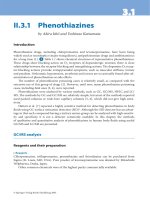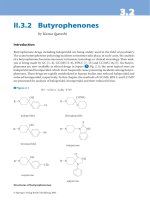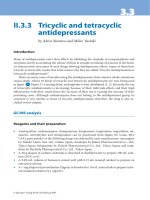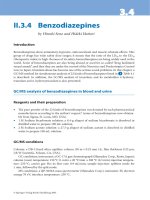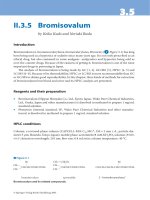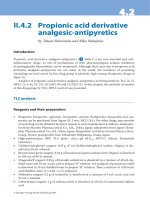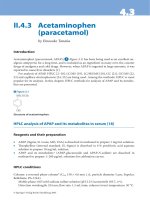Tài liệu Keep Your Shop in Tune A Best Management Practices Guide for Automotive Industries docx
Bạn đang xem bản rút gọn của tài liệu. Xem và tải ngay bản đầy đủ của tài liệu tại đây (5.14 MB, 62 trang )
Keep
Your Shop
in Tune
A Best Management Practices Guide
for Automotive Industries
www.ecobiz.org
This manual was prepared by the
Pollution Prevention Outreach Team
This team is a multi-agency cooperative group working toward a cleaner environment.
The following program partners helped develop and review this document.
• City of Gresham
• City of Portland
Environmental Services
Energy Division
Bureau of Water Works
• City of Troutdale
• Clackamas County
Water Environment Services
• Clean Water Services
• Metro
• Northwest Automotive Trades Association (NATA)
• Oregon Department of Environmental Quality
Pollution Prevention, Small Business Assistance, Water Quality,
Solid Waste, Hazardous Waste, Air Quality
• Washington County
Also A Special Thanks To:
• Oregon state Fire Marshall
• Oregon Occupational Safety and Health Administration
• Washington State Department of Ecology
“Managing Hazardous Wastes: A Guide for Automotive Repair Shops”
• Santa Clara Valley Non-point Source Pollution Control Program
“Best Management Practices for Automotive-Related Industries”
Pollution Prevention Outreach Team
6543 North Burlington Avenue
Portland, Oregon 97203-5452
503-823-7807
www.eco.biz.org
Keep Your Shop in Tune
A Best Management Practices Guide for Automotive Industries
Keep Your Shop in Tune
A Best Management Practices Guide for Automotive Industries
CONTENTS
Your Requirements as a Generator . . . . . . . . . . . . . . . . . . . . . . . . . . . 3
Run A Dry Shop . . . . . . . . . . . . . . . . . . . . . . . . . . . . . . . . . . . . . . . . . . 5
Limit Your Discharges . . . . . . . . . . . . . . . . . . . . . . . . . . . . . . . . . . . . . 9
Changing Automotive Fluids . . . . . . . . . . . . . . . . . . . . . . . . . . . . . . 11
Filters and Brakes . . . . . . . . . . . . . . . . . . . . . . . . . . . . . . . . . . . . . . . 15
Fueling Vehicles . . . . . . . . . . . . . . . . . . . . . . . . . . . . . . . . . . . . . . . . . 17
Air Conditioning Repair. . . . . . . . . . . . . . . . . . . . . . . . . . . . . . . . . . . 19
Cleaning Equipment and Parts . . . . . . . . . . . . . . . . . . . . . . . . . . . . . 21
Vehicle Washing, Engine Cleaning and Steam Cleaning. . . . . . . . . . 23
Metal Grinding and Finishing . . . . . . . . . . . . . . . . . . . . . . . . . . . . . . 25
Car Prep, Body Work and Refinishing . . . . . . . . . . . . . . . . . . . . . . . . 27
Radiator Shops . . . . . . . . . . . . . . . . . . . . . . . . . . . . . . . . . . . . . . . . . 29
Outdoor Parking and Auto Maintenance . . . . . . . . . . . . . . . . . . . . . 31
Auto Recycling. . . . . . . . . . . . . . . . . . . . . . . . . . . . . . . . . . . . . . . . . . 33
Removing and Storing Batteries . . . . . . . . . . . . . . . . . . . . . . . . . . . . 35
Storage and Disposal of Wastes and Containers . . . . . . . . . . . . . . . 37
Selecting and Controlling Inventory . . . . . . . . . . . . . . . . . . . . . . . . . 43
Other Practices to Control Pollution . . . . . . . . . . . . . . . . . . . . . . . . . 45
Solid Waste Reduction. . . . . . . . . . . . . . . . . . . . . . . . . . . . . . . . . . . . 47
Water and Energy Savings . . . . . . . . . . . . . . . . . . . . . . . . . . . . . . . . 49
Energy and Water Experts. . . . . . . . . . . . . . . . . . . . . . . . . . . . . . . . . 50
Train Yourself, Your Employees and Your Customers . . . . . . . . . . . . 51
Show Your Stuff . . . . . . . . . . . . . . . . . . . . . . . . . . . . . . . . . . . . . . . . 53
Appendix A - Resources. . . . . . . . . . . . . . . . . . . . . . . . . . . . . . . . . . . 55
Appendix B - Glossary . . . . . . . . . . . . . . . . . . . . . . . . . . . . . . . . . . . . 57
W
hen a car is properly main-
tained, it runs cleaner and
more efficiently, and costs less to
operate. The same is true for an
automotive repair shop. By keep-
ing your shop “in tune,” you can
run a cleaner, more efficient shop
and save money.
Keep Your
Shop in Tune
A Best Management Practices Guide for Automotive Industries
Automotive related industries
create a variety of wastes, some
of which may be classified as haz-
ardous. This handbook describes
Best Management Practices (BMPs)
for automotive shops and related
industries to help control and
prevent pollution.
BEST MANAGEMENT PRACTICES
ARE RECOMMENDED PROCEDURES
THAT WILL HELP YOU:
• Comply with government mandated environmental require-
ments. (Specific regulations may vary from one municipality
to another. Use this handbook in conjunction with the ordi-
nances in your community. Environmental regulations can be
complex. This handbook does not cover all potential items.)
• Save money by finding ways to reduce or recycle your
wastes.
• Show customers they have made a wise choice by selecting a
shop that protects the environment.
• Protect public health and the health and safety of your
workers, by eliminating, reducing and controlling wastes.
• Reduce your liability by reducing your potential for site
contamination.
• Join other automotive repair shops in Oregon that are tak-
ing pride in maintaining a clean and healthy environment.
Automotive Industry Wastes
The individual sections in this handbook discuss solutions to a variety of automotive service
related pollution problems, listing Dos and Don’ts for proper handling of process wastes.
Reducing pollution may not be as hard as you think. A good place to start is to walk through
your shop and review all of the processes that use toxic chemicals or generate waste. You
should be able to use the information provided here to make at least one positive change for
our environment.
More Information
✔ For information about the Ecological Business Program, Mercury Switch Out and related
programs, call the Northwest Automotive Trade Association (NATA) at 503-253-9898.
✔ For more information about state and federal requirements about proper waste
management and disposal in the Tri-County area, call the Oregon Department of
Environmental Quality, Northwest Region Office, at 503-229-5263.
✔ For more information about recycling and proper solid and hazardous waste
disposal options, call Metro Recycling Information at 503-234-3000. This is also the
number to call for information about Metro’s Conditionally Exempt Generator program
for Hazardous Waste.
✔ For information about local sewage, stormwater and solid waste disposal
ordinances and recycling options, call your local jurisdiction:
City of Gresham, 503-618-2525
City of Portland (sewer/stormwater), 503-823-7740 (solid waste) 503-823-7202
City of Troutdale, 503-665-5175
Clackamas County, (sewer/stormwater), 503-353-4567 (solid waste) 503-353-4400
Clean Water Services, (sewer/stormwater) 503-846-8931
Washington County (solid waste), 503-648-8609
✔ Other information
Oregon OSHA, Health and Safety, 503-229-5910
State Fire Marshall*, 503-378-3473
*
Check local listings for your area Fire Marshall
For information about Ecological Business Program certification outside of the greater
Portland area, contact NATA at 503-253-9898.
2
A
utomotive repair shops become regulated generators if they
generate more than 220 pounds of hazardous waste per
month or have more than 2,200 pounds of hazardous waste on
site. (220 pounds is about one half of a 55-gallon drum).
METRO’S CEG HAZARDOUS WASTE PROGRAM
Shops that generate less than this amount of hazardous waste are considered
Conditionally Exempt Generators (CEGs) and are not required to register with DEQ as
a hazardous waste generator. Shops that do register as CEGs and obtain a generator
number from DEQ as part of Metro’s application process are then eligible to use
Metro’s CEG Hazardous Waste program. Metro will accept hazardous waste from
CEGs at its two household hazardous waste facilities in NW Portland and Oregon
City. Appointments are required and there is a charge for this service. Call Metro at
503-234-3000 for more information and an application package.
UNIVERSAL WASTE
You can further reduce the amount of materials listed toward your hazardous waste
generator status by reviewing waste streams that may fall under the DEQ Universal
Waste Rules. Pesticides, mercury-containing thermostats, fluorescent light tubes, and
all types of batteries can all be handled as Universal Wastes. Contact DEQ at
503-229-5263 or online at for more
information.
MERCURY SWITCH OUT PROGRAM
Mercury is a persistent toxic compound in the environment that has been proven to
cause negative health effects. Mercury is present in various light switch assemblies in
new and used vehicles, especially American models. Automotive service shops are
encouraged to participate in a new program sponsored by DEQ, NW Automotive
Trades Association, the Oregon Environmental Council and the
Port of Portland. The program removes and replaces mercury
switches in cars to prevent the release of mercury into the envi-
ronment when vehicles are scrapped. For more information on
this program see the NATA (www.asaoregon.org) or Ecobiz
(www.ecobiz.org) websites or call NATA at 503-253-9898.
GENERATOR REQUIREMENTS
Your Requirements
as a Generator
3
Remember: Solvents and
other substances are not
wastes until the day they
are no longer usable and
are ready for disposal.
Your Requirements As a Generator
4
USED OIL
DEQ requires facilities to properly manage used oil. You can use a registered
used oil transporter to take your oil to a used oil processor.
You can also burn used oil in a space heater if the used oil
heater has a capacity of less than 0.5 million BTUs per hour
and is operated according to manufacturer’s specifications.
Burning used oil for shop heating, while acceptable, is not
recommended due to the potential to release heavy metals
as air pollutants. If you are using waste engine oil for shop
heating, be sure that no other wastes are added like solvents
or paints.
Never add any hazardous waste, like chlorinated solvents
or used antifreeze, to used oil. Adding these wastes may
render the used oil a hazardous waste and may substantially increase your
disposal costs.
ALL REGULATED AND CONDITIONALLY EXEMPT
GENERATORS SHOULD FOLLOW STEPS 1
THROUGH 6 OUTLINED BELOW:
These steps are required for regulated generators and suggested for
Conditionally Exempt Generators.
Step 1 - Identify Your Waste and Generator Status (Required for everyone)
Check waste to see if it exhibits any of the hazardous waste characteristics
(ignitability, corrosivity, reactivity, toxicity) or appears on any hazardous
wastes list, either state or federal. Additionally, DEQ allows recycling
petroleum-contaminated wastewater provided there is enough fuel in it to
warrant reclamation.
Step 2 - Obtain a Generator Identification Number
Regulated generators are required, and CEGs are encouraged, to obtain a site-
specific EPA/DEQ Generator Identification Number. Forms are available from
DEQ, 503-229-6511 and Metro, 503-234-3000. Many hazardous waste haulers
and management facilities may not accept your waste if you don’t have an iden-
tification number, even if you’re a CEG and aren’t legally required to have one.
An identification number is required to take advantage of Metro’s CEG
Hazardous Waste Program.
Step 3 - Manage Containers Properly
Many hazardous waste incidents and work-related injuries are linked
to improper or unsafe container management. To avoid these
preventable accidents:
• Do not accumulate incompatible wastes (like acids and bases, or oxidizers and flam-
mable material) in the same container or in the same storage areas;
• Store reactive and ignitable wastes according to the Uniform Fire Code;
• Make sure your hazardous waste storage area is clearly marked;
• Consider the location of containers with respect to: floor drains, electrical service
panels, heat sources, customer/employee walkways, building access/egress by the
public; and with respect to security and protection from vandalism.
Step 4 - Record Keeping
• Record all information used to identify when, who and by what means your waste
was determined to be hazardous or non-hazardous. Keep this documenta-
tion onsite.
• For both hazardous and non-hazardous waste, record all information
about hauling and disposal. Note how much, when, and by whom
(including their address, phone, etc.) it was picked up for disposal or recy-
cling. Include the transporter’s and destination facility’s EPA identifica-
tion numbers if the waste was hazardous.
Step 5 - Arrange for Proper Transportation and Disposal
You are responsible for following regulations for the safe transportation and
disposal of your waste, even after it leaves your premises. If you exceed the
CEG waste quantities you must hire a transporter that has an EPA/DEQ Identification
Number and ensure wastes are handled at a permitted hazardous waste treatment,
storage or disposal (TSD) facility. If you are a CEG you may transport your own waste
in accordance with DOT requirements to an approved disposal facility or one that
legitimately recycles or reclaims hazardous waste. Call DEQ at 503-229-5263 to verify
the transporter’s Identification Number or for more information about the TSD facility
closest to your shop.
Step 6 - Plan for Emergencies
Planning for emergencies can help prevent a small spill from turning into a dangerous
and expensive contamination problem. Make sure you train your employees to know
how to react to different types of emergencies in your shop. Be sure there is always
someone on-site with authority to commit the resources necessary to deal with a haz-
ardous waste emergency. Make sure workers who are assigned spill response and haz-
ardous materials handling have adequate training to meet OSHA requirements for their
assigned job duties.
DEQ has worksheets available to calculate your Hazardous Wastes. Some wastes
might require a laboratory analysis to determine if they are hazardous or not. DEQ
also has free training classes on hazardous waste management as well as an online
training program.
5
Your Requirements As a Generator
6
T
he purpose of
spill control is
to keep spills small
and localized, to
avoid discharges to
the storm or sani-
tary sewer system,
and to reduce your
cleanup expenses
and liabilities. You
can comply more
easily with sewer
and stormwater
requirements by
cutting down on
the liquids you dis-
charge intentionally
or accidentally
through spills. If
you are successful,
your shop’s dis-
charge will be limit-
ed to wastewater
from your bath-
rooms going to the
sanitary sewer and
rain water from
your roof and park-
ing lot going to the
storm sewer.
Spill Protection
DO:
• Have spill kits easily available, clearly labeled, located near
drain systems or near liquid storage locations, and assure staff
is trained on kit location and use.
• Keep a drip pan under the car while you unclip hoses, unscrew
filters or remove other parts. Drain fluids from vehicles that
will be stored for long periods.
• Have funnels or pumps available to dispense chemicals.
• Use shop wipes for small spills and dry absorbent material for
larger spills.
• Sweep the floor rather than wet mopping or spraying it down
with a hose. Use a damp mop for general cleanup. Consider
sealing floors with non-skid impervious materials for easier
clean up.
• Seal floor drains if possible. Verify that your work area drains
are connected to the sanitary sewer. Pretreatment may be
required prior to discharge into the sanitary sewer. Wastewater
should never be discharged into storm drains or into on-site
drywells.
• Maintain your equipment. Periodically check equipment used
to clean up spills and leaks. Also routinely check all shop
equipment for small leaks and other repair needs.
• Stencil your storm drains as a reminder that storm drains dis-
charge to local waterways. Stencils are available from your
local sewerage agency.
DON’T:
• Don’t allow spills, drips and splatters to sit for a long time
before cleaning up. These materials can wash away as water
pollution or evaporate and contribute to air pollution.
• Don’t leave drip pans or other open containers unattended, to
prevent spills. Empty containers when they become at least
half full.
• Don’t keep chemicals open to the air. Sealing containers with
tight-fitting lids will prevent spills and limit evaporation.
Tight lids also prevent the release of fumes that can create a
fire hazard.
continued
DRY SHOP
Run A Dry Shop
7
DON’T continued:
• Don’t wash down or wet mop a spill. Washing just makes the
material more mobile and can increase the overall volume of
contaminated rinse water to manage as waste.
• Don’t throw away dry absorbent if it can be reused. Wring liq-
uids into an appropriate liquid waste container. Use personal
protective gear when cleaning up spills.
• Don’t assume used absorbents can be thrown into the dump-
ster. Determine whether the waste absorbent is a hazardous
waste. If not, ask your garbage hauler whether they can go
into the solid waste dumpster.
• Don’t forget to clearly label your spill kit so that it is not acci-
dentally used as a trash can. It should be easy to locate quickly
during an emergency.
• Don’t rely on dry absorbents alone. Spill kits should also con-
tain absorbent pads and booms to contain spills. Consider use
of inlet mat covers to keep drains from conveying your spill
off your site.
• Check with your local sewerage agency to find out where your
drains lead. Most outside drains and some inside drains don’t
go to a sewage treatment plant but instead lead directly to a
stream, lake or ditch. They may drain to drywells and contam-
inate groundwater.
8
Run a Dry Shop
C
losing the loop
on many of
your services and
processes by
reusing solvents,
cooling waters, and
other catalysts can
help reduce or
eliminate the need
to discharge
wastes. The less
waste generated,
stored or dis-
charged, the lower
your regulatory
and permit
requirements.
DO:
• Prevent leaks and spills.
• Use shop equipment that does not produce wastewater. If you
must use solvents, try to contain chemicals by using enclosed
parts cleaners. Reuse solvent many times before disposal.
• Use recyclable and reusable products, when possible.
• Hire a recycling service to pick up used solvent and
anti-freeze, or recycle them onsite with a filtration or
distillation unit.
• Consider switching to water-based brake and carburetor
cleaners instead of using chlorinated spray cans.
Non-chlorinated solvents are also available.
• Keep an accurate inventory of all materials and wastes, in case
of an audit by DEQ. Don’t forget to keep track of recyclable
scrap materials like metal and scrap paper. Correctly manifest
hazardous wastes. Ask for and maintain a Material Safety Data
Sheet (MSDS) on each chemical product used in your shop.
The Oregon Occupational Safety and Health Administration
(OROSHA) requires employees to know the location of the
MSDS for each substance they use.
• Provide secondary containment for all liquid materials stored
and used in your shop. Containment measures should be sized
to hold 110% of the largest container. For example your
containment measure needs to hold 60 gallons for a
55-gallon drum.
• All hazardous materials and hazardous wastes should be kept
in closed containers unless materials or wastes are being trans-
ferred to or from the container. Used oil containers may be
open for draining filters and other parts, but only when kept
inside. Used oil stored outside must be kept in closed contain-
ers at all times.
DON’T:
• Don’t use single pass cleaning units that expend high volumes
of water or solvents.
• Don’t dispose of materials that can be reused, recycled or
traded such as solvents, batteries, metal scrap, scrap paper,
cardboard, and used automobile parts. Send shop towels to an
industrial laundry service.
continued
LIMIT YOUR DISCHARGES
Limit Your Discharges
9
DON’T continued:
• Don’t mix wastes. Combining wastes reduces your ability to
recycle and can greatly increase your disposal costs.
• Don’t throw away dirty solvent. Use it first before fresh solvent
when cleaning parts. Using filters on parts washers can extend
the life of the solvent by allowing reuse multiple times before
disposal.
• Don’t assume secondary containment must be a large tank or
concrete wall. Consider using your shop floor. Perimeter/bay
door speed bumps may be sufficient to hold spills. Any con-
tainment berming must be sealed into place with epoxy.
• Don’t let spills get off your site. Consider using conical plugs,
valves or oil check valves in all shop drains. These measures
close off drains to protect them from spills. Open them to drain
off approved discharges. Remember to re-close these measures
when the approved discharge is complete.
Limit Your Discharges
10
T
he removal,
storage and
disposal of fluids
are major causes of
pollution for auto
related industries.
Follow these guide-
lines to protectively
manage fluids used
in your shop.
General Tips
DO:
• Drain and replace motor oil, coolant and other fluids in areas
where there are no floor drains. If you must use floor drains,
connect them to a holding tank. If drains connect to the sewer
system, install an oil/water separator.
• Collect the spent fluids, store them in separate containers and
recycle them when possible.
• Collect leaking or dripping fluids in drip pans. Remove
materials from drip pans often.
• Separate oils that can be reused, from those that can’t. Store
them in labeled containers that read “Reusable Oil Only” and
“Used Oil Only.” Send used oil to an oil processor. Used oil
handled in accordance with DEQ requirements does NOT
count toward your hazardous waste generator status.
• Store hazardous waste fluids separately in a specifically
designated hazardous waste storage area. Know which fluids
are a safety risk when stored next to each other.
• Try not to mix leaking fluids. Mixing can contaminate the
fluids and turn it all into hazardous waste.
DON’T:
• Don’t incorrectly dispose of any hazardous waste. Recycle
used antifreeze. Chlorinated and other solvents are considered
hazardous wastes if not immediately recycled in your shop.
• Don’t dispose of automotive fluids to storm drains, septic
tanks, or dry wells. Never pour fluids on the ground.
• Don’t mix any wastes other than automotive oils with used oil
if it is used for shop heating.
AUTOMOTIVE FLUIDS
Changing Automotive Fluids
11
Antifreeze
DO:
• Determine if filters and other recycling by-products are haz-
ardous waste and manage them accordingly if you recycle
antifreeze on the premises.
DON’T:
• Don’t mix waste antifreeze with any other waste. DEQ policy
prohibits mixing antifreeze waste with used oil.
Brake Fluid
DO:
• Recycle brake fluids with your used oil if the material is going
to a recycler. It is also permissible to mix hydraulic fluid and
lubricants with your used oil before recycling. Call your used
oil recycler for their requirements.
DON’T:
• Don’t mix brake fluids with other fluids if they are contami-
nated with a chlorinated brake or carburetor cleaner. Store and
label them separately as a hazardous waste.
• Don’t mix brake fluid with your used oil if the shop is heated
with a used oil burner.
Changing Automotive Fluids
12
Crude-Based Fluids
DO:
• Manage used crude-based fluids like you do used oil - reuse
and recycle.
DON’T:
• Don’t mix crude-based fluids with used oil if they are contami-
nated with brake or carburetor cleaner, or other wastes.
Radiator Fluids
DO:
• Recycle radiator fluids with antifreeze. If necessary, switch
brands to make recycling possible.
• Reuse radiator fluids through distilling or recycling onsite to
minimize waste generation.
DON’T:
• Don’t mix radiator fluids with used oils - it violates DEQ poli-
cy and limits the ability to reuse and easily dispose of the
resulting mixed material.
Changing Automotive Fluids
13
C
rude-based flu-
ids include
used engine oil,
transmission fluid,
hydraulic fluid,
gear lube oils,
metal working oils
and differential
oils. These fluids
can be managed as
used oil. When
recycled, crude-
based fluids are
not considered
hazardous unless
contaminated with
hazardous wastes
such as chlorinated
solvents. However,
if these fluids are
not recycled, they
may require
hazardous waste
handling.
You can avoid
hazardous waste
regulations when
disposing of crude-
based fluids by
recycling with a
used oil recycler.
14
S
ome automo-
tive filters may
pick up hazardous
materials while
performing their
function. Other
types are not
hazardous and
can be recycled
rather than
thrown away.
B
rake work has
several specific
hazards such as
asbestos from older
brakes and chlori-
nated solvents.
Asbestos is a
Special Waste and
can be disposed of
only in a landfill
licensed for
asbestos.
Filters and other wastes
Type How Managed Hazardous Who Handles
Oil Filters Puncture into Possibly Recycler
drain drum
or crush
Fuel Filters Drain drum Yes if gasoline, Hazardous waste
no if other fuel recycler
Air Filters Normal Waste Unlikely Municipal waste
or recycler
Solvent Drum Probably Hazardous waste
Tank Filters
Freon Normal Waste Possibly Recycler
Antifreeze Drum Not if recycled Recycler
Brakes
DO:
• Use a HEPA vacuum filter system to remove dust from brake
area. Most old brake shoes contain asbestos. The fine dust is a
health hazard and should be handled as a Special Waste. Even
brake dust without asbestos can release metal pollutants, like
copper, into the environment.
• Use a birdbath brake washer. This lessens asbestos exposure for
workers and avoids the use of chlorinated brake spray cans.
Manage the sludge from the bird bath washer as a Special Waste.
DON’T:
• Don’t use chlorinated aerosol sprays for brake cleaning. They are
a health hazard and once used are a hazardous waste.
FILTERS AND BRAKES
Filters and Brakes
15
16
I
n general, your
fueling area
should be designed
and operated to
minimize spills and
to control leaked
fluids so they don’t
come in contact
with stormwater.
DO:
• Clean up spills immediately with the Dry Shop Dos. (see
pages 7-8). Spread absorbent material and sweep it up with a
broom. Do a hazardous waste determination, and dispose of
sweepings properly.
• Clean up using a damp cloth on the pumps and a damp mop
on the pavement area.
• Contact your fire department about their rules concerning the
installation of fuel pump shut-offs.
• Install containment or other design features on all fuel tanks,
including temporary tanks, as specified by your local fire
department. Underground material storage tanks must also
meet DEQ requirements.
• Cover fueling areas and drain all covered areas into an
oil/water separator. Drain areas outside of fueling islands to
the storm sewer.
DON’T:
• Don’t allow vehicle fueling in unauthorized areas. Fueling
areas should be paved, graded and drained properly.
• Don’t hose down your fueling area for cleanup. This water
then becomes an illegal discharge to either the sanitary or
storm sewer. Gasoline is not only a troublesome pollutant but
can create a high explosion danger in sewers and is expensive
to clean up.
• Don’t drain oily wastewater or spills directly into the sewer or
storm drain. To prevent spills from reaching these systems, the
fueling area must be equipped with an emergency shut-off.
Use oil/water separators or other devices as needed to keep
oily wastes out of your discharge.
• Don’t allow customers to wash their vehicles, change oil or
work on cars in parking and approach areas.
Fueling Vehicles
17
FUELING VEHICLES
18
DO:
• Use EPA approved refrigerants.
• Allow only EPA-certified technicians to service air condition-
ing systems.
• Use EPA-approved collection and recycling equipment that
meets the SAEJ 1991 or SAEJ 2209 standards and maintain it in
good repair.
• Perform a leak test before recharging any air conditioner.
• Keep technician certification and shipment manifests on-site
for at least three years.
DON’T:
• Don’t vent freon to the atmosphere. Use EPA-approved equip-
ment to contain freon gasses.
• Don’t dispose of worn out air conditioners without first
removing and recycling the freon.
AIR CONDITIONING REPAIR
Air Conditioning Repair
19
For more information
call the DEQ NW Region
at 503-229-5364.
20
W
henever pos-
sible, clean
parts without liquid
cleaners. If you
use chlorinated
solvents, your shop
is subject to
National Emission
Standards for
Hazardous Air
Pollutants (NESHAP)
and DEQ Permitting.
If you use parts
washers that
contain volatile
organic compound
(VOC) solvents and
you are located in
the Portland,
Salem or Medford
Air Quality
Maintenance
areas, then you are
subject to DEQ’s
Reasonably
Available Control
Technology
(RACT) rules.
Call DEQ’s
Northwest Region
at 503-229-5554 for
information about
these requirements.
The RACT rules
include equipment
specifications and
specific work prac-
tices that are not
necessarily included
in BMPs listed here.
DO:
• Prevent solvents and cleaners from spilling and dripping onto
the shop floor. Install drip pans, drain boards and drying racks
in a way that directs drips back into the sink or the fluid hold-
ing tank
• Use self-contained solvent sinks to cycle liquid directly back
into a storage drum. Several services will pick up spent sol-
vent. Be sure to get the maximum use out of the solvent before
pick up. Try filtering systems to see if solvents can be changed
out less frequently in recycling tanks.
• Minimize the amount of liquid cleaners used. Scrape parts well
with a wire brush or use a bake oven to remove coarse parti-
cles that can dirty cleaning solutions. Use dirty cleaner for the
first wash, followed by clean cleaner. Keep two containers for
each solvent - one for dirty solvent and one for clean. Clearly
label these containers.
• Use shop towels to clean small parts. By using a pump dis-
penser rather than pouring, your shop will use less cleaner,
you’ll save money, and your shop will generate less pollution.
• Use filters on cleaner tanks to help clean dirty solvent for
reuse. Consider using recycling or distillation units that can
prolong the life of your solvent. You need to remove a small
amount of residue from the machine after use, which might
require management as a hazardous waste.
• Consider using non-hazardous or less hazardous solvents and
cleaners. Many washers use hot water and detergents instead
of hazardous fluids. They are safer for your employees and
may rid you of hazardous waste disposal problems. Note that
non-hazardous solvents can become contaminated through use
with chlorinated rattle can solvents, trace benzene from gaso-
line, or heavy metals such as lead from parts, making them
hazardous waste.
• Be sure that your cold cleaner is equipped with a cover that is
easily opened and closed. The cleaner must also have a drain
rack, suspension basket, or suspension hoist that returns the
drained solvent to the solvent bath. The bath shall remain less
than 50% of the volume of the cleaning container and must
have a visible fill line. Maintain cold cleaners in good working
condition and free of solvent leaks.
continued
CLEANING EQUIPMENT
Cleaning Equipment and Parts
21

